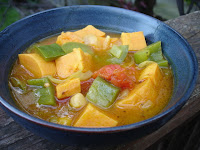Recently, I was strangely delighted to find this post on Horrifying Foodstuffs, titled
Of Karl Marx and Cool-Whip.
A particularly striking observation that the author, Poppy Buxom, makes about this food product is this:
"My idea is that Cool-Whip is designed for only one thing: to make people get fat by getting them to consume highly caloric non-foodstuffs. In that, of course, it is not alone; there are millions of junk foods with the same goal."
She goes on to explain her idea that if people were more connected to the process of obtaining (making) whipped cream, they would eat considerably less of it.
Why would our culture need a bounty of "highly caloric non-foodstuffs"? With its low price tag and instant gratification, foods such as Cool-Whip and hundreds of other highly processed things that people eat tend to be pantry staples of the working class, especially the "working poor". The conflict theorist Karl Marx called the working class the
proletariat. Marx claimed that workers become alienated as a result of being exploited by the
capitalist. In particular, the proletariat is alienated from their work, their product, other people, and their
species being. This last refers to the human nature to enjoy the process of making things.
 |
| Karl Marx |
Food provides us with an excellent modern example of Marx's theory. The proletariat working at the Cool-Whip plant puts in long hours, probably is part of a dual-income household with children, comes home at the end of a long shift, and doesn't have the time, energy or inclination to make dinner. What does he or she do? More often than not, working people will reach for convenience foods, which provide fast energy through high sugar, calories, and fat. Dinner becomes an example of alienation from one's species being.
 |
| Miners in Cornwall |
Historically, the working class enjoyed a diet that was more connected to the farm or garden. A great example of proletariat food of yesteryear is the Cornish Pasty. This humble, homemade hand-held pie was hardly haute cuisine, but it provided workers with carbohydrates, fat, protein, and sugar in a handy, high-calorie package.
 |
| Cornish Pasty |
This week's recipe is for Cornish Pasties. Find a recipe on
this link at Allrecipes.com. If you prefer an all-vegetable pasty, try
this recipe instead.
I'll close this post by pointing you to
this interview with Rob Albritton, author of
Let Them Eat Junk: Capitalism and Food. Here is a notable excerpt:
"In my interpretation “junk food” epitomises capitalist food in this phase of history, and junk food is high in sugars, fats and salts, while being low in other nutrients. My book does not focus narrowly on junk food, but on a food system whose cutting edge has been junk food and whose largest corporations tend to be centred in the US, expanding outward to the rest of the world. The main themes of the book are the food system’s failure to advance human health, environmental health or social justice; and the connections between the food crisis and the myriad of other crises characteristic of late capitalism."
Albritton's book takes a close look at capitalism and its impact on the distribution of food in our society. He addresses the irrational and unsustainable nature of the current system, and proposes democratization of the labor market as one means of addressing this problem.
I want to invite you all to take a closer look at your food; to see the faces behind what you are consuming.
















































